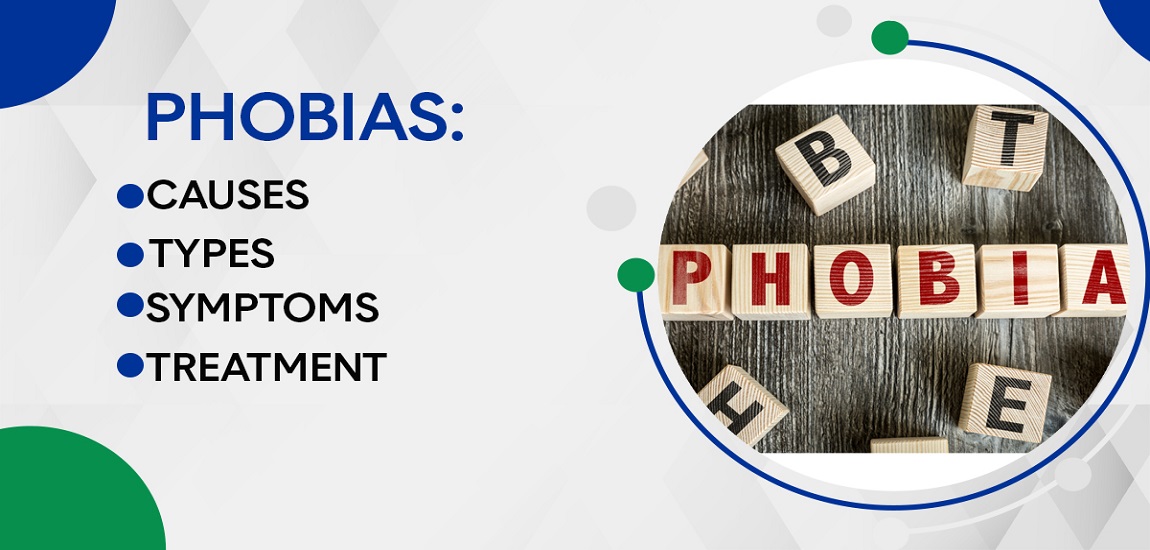
- By JRSH Admin
- In Health and Tips,
- Posted July 26, 2022
Phobias: Causes, Types, Symptoms & Treatment
Phobias are characterized by extreme and irrational fears about certain situations, creatures, places, or things.
It is common for someone who suffers from a phobia to shape their lives to avoid things they consider dangerous. It is more dangerous to imagine a threat than to confront the cause of terror.
It is possible to diagnose phobias as mental disorders. If the source of the phobia is confronted, the person will suffer intense distress. Panic attacks can sometimes result from this, preventing them from functioning normally.
What are Phobias?
There are many types of phobias, but phobia is an exaggerated and irrational fear of an object or situation that poses little or no danger in reality. An individual who avoids a distressing object or situation to the point of extremes has developed a phobia.
It is important to note that phobias, which fall under the category of anxiety disorders, are not caused by a malfunction of the brain and are manageable. When faced with a terrifying situation, people begin to restrict their lives out of fear.
Although phobias seem like irrational fears, they usually have a reason behind them. There is no age or background limit to the number of people who can experience phobias across the world.
Objects and situations that people dread usually result in certain emotional and physical reactions. It may become so intense that a person becomes paralyzed and incapable of performing normal tasks.
Fears are common among children. When left untreated, these fears may turn into phobias. Developing phobias and experiencing nightmares in young children is possible. They are more commonly related to natural phenomena such as lightning and thunder.
Rather than letting the child's fears grow out of proportion and haunt the child for the remainder of his or her life, parents and other responsible adults should address the situation and help the child overcome his or her fears before they become unmanageable.
Types of Phobia
Phobias are classified into several different types in the Diagnostic and Statistical Manual of Mental Disorders, 5th Edition (DSM-5). Phobias can be classified into three types:
- Specific phobias: Flying, dogs, feet, or heights are examples of specific phobias: intense, persistent, and marked fears of specific objects or situations. It is possible for people who suffer from specific phobias to know that their anxiety is unwarranted or unnecessary, but they cannot control their distress.
- Agoraphobia: When a person has agoraphobia, they fear being trapped in an environment where escape is difficult or help might not be available in the event of panic or other incapacitating symptoms.
- Social phobia: The symptoms of social phobia, also known as social anxiety disorder, include intense fear and self-consciousness. When people suffer from social phobia, they may avoid public speaking, attending events, meeting new people, or even seeking employment.
Phenomena related to anxiety disorders include all three types. Anxiety disorders affect about 30% of U.S. adults. Specific phobias are diagnosed in between 3% and 15% of the population.
Common phobias
The most common phobias include fear of:
- Fear of Spiders (Arachnophobia)
- Fear of Social situations (social phobia)
- Fear of Flying (Aviophobia)
- Fear of Open Spaces (Agoraphobia)
- Fear of Confined spaces (Claustrophobia)
- Fear of Heights (Acrophobia)
- Fear of Cancer (Cancerophobia)
- Fear of Thunderstorms (fear of lightening – Astraphobia; fear of thunder – Brontophobia)
- Fear of Death (Necrophobia)
- Fear of Heart disease (Cardiophobia)
Less Common Phobias
Other less common phobias are fears of:
- Fear of Needles/sharp objects (Aichmophobia)
- Fear of Cats (Ailurophobia)
- Fear of People (Anthropophobia)
- Fear of Men (Androphobia)
- Fear of Sex (Genophobia)
- Fear of Women (Gynophobia)
- Fear of Water (Aquaphobia)
- Fear of Bees (Apiphobia)
- Fear of Toads (Bufonophobia)
- Fear of Dogs (Cynophobia)
- Fear of Dentists and doctors (Dentophobia and Iatrophobia respectively)
- Fear of Reptiles (Herpetophobia)
- Fear of Sleep (Hypnophobia)
- Fear of Mice (Musophobia)
- Fear of Dirt and germs (Mysophobia)
- Fear of Anything new (Neophobia)
- Fear of Night (Noctiphobia)
- Fear of Darkness (Nyctophobia)
- Fear of snakes (Ophidiophobia)
- Fear of Fire (Pyrophobia)
- Fear of Being buried alive (Taphophobia)
- Fear of God (Theophobia)
- Fear of Strangers (Xenophobia)
- Fear of Animals (Zoophobia)
Causes of Phobias
Phobias don't seem to have any particular cause. Various factors can contribute to the development of a phobia. Often, there is no obvious cause for its onset.
- Past incidents or traumas. There are certain situations that might have a lasting effect on how you perceive them. Flying phobias may develop as a result of experiencing turbulence on a plane as a child. Perhaps you developed a phobia of dogs after being injured by a dog years ago.
- Learned responses from early life. The environment in which you grew up may have contributed to your phobia. Parents or guardians might be anxious or worried about you, for example. Taking care of your anxiety now may affect how you cope with it in the future. The phobia you develop may be the same as those of your parents or older siblings. It is possible that you may have the same feelings about something they fear if they have a severe reaction to it.
- Reactions and responses to panic or fear. If you are faced with a situation or object that triggers a strong reaction, or a panic attack, then you may have a strong reaction. There may be a sense of embarrassment attached to this. Particularly if your response is met with strong reactions from people around you. The idea of this happening again might cause you even more anxiety.
- Experiencing long-term stress. It is possible to experience anxiety and depression as a result of stress. Particular situations can be made more difficult by it. As a result, you may feel more nervous or anxious in similar situations in the future. An individual could become phobic if this continues for a long time.
- Genetic factors. Phobias are more likely to develop in some people than in others, according to research.
Symptoms of Phobias
There are several symptoms common to all types of phobias, including panic and fear; racing heartbeats; difficulty breathing; shaking or trembling, and a desire to leave. Phobias can also present unique symptoms depending on the kind of fear they cause.
It is also possible to divide symptoms into physical and emotional symptoms.
Physical Symptoms
- Trembling or shaking
- Sweating
- Racing heart
- Difficulty in breathing
- Nausea
- Dry mouth
- Chest pain or tightness
Emotional Symptoms
- Feeling overwhelmed by anxiety or fear
- Feeling powerless to overcome your fear despite realizing it is irrational
- A feeling of being out of control
- Escape feeling intensely compelling
In the case of social anxiety disorder, symptoms include avoiding social situations or experiencing intense discomfort in those situations.
Agoraphobia is also characterized by fear or avoidance of certain situations, such as being alone outside your home or being in a crowded or enclosed area.
However, by avoiding these situations, people usually fear that they will experience anxiety or panic attacks in these settings and will not be able to escape or seek assistance.
Specific Phobia Symptoms
If you have any kind of specific phobia (a fear of clowns or dogs, for example) you may experience the following symptoms that include:
- When the source of the phobia is present (or when thinking about it), fear, anxiety, and panic may occur
- Having difficulty controlling or subduing a fear
- The intensity of anxiety increases as you approach the source
- Keeping as far away from the source of the fear as possible
- Experiencing debilitating anxiety when confronting the source if avoidance is impossible or difficult
- Phobias may make it difficult for you to function normally or to the best of your ability.
Phobia Risk factors
Here are some factors that may increase the risk of your specific phobias:
- Your age. It is common for specific phobias to appear in childhood, usually by the age of 10, but they can also develop later in life.
- Your relatives. Anxiety or phobias are more likely to develop in you if a member of your family has them. There may be an inherited tendency to develop phobias, or children may learn specific phobias from watching their family members react to situations or objects.
- Your temperament. Increasing your risk may be the result of being more sensitive, inhibited, or negative than normal.
- A negative experience. An experience that causes a specific phobia, such as being trapped in an elevator or being attacked by an animal, may trigger the development of a specific phobia.
- Learning about negative experiences. The development of a specific phobia can result from hearing negative information or experiencing negative experiences, such as plane crashes.
Complications of Phobias
The problems that specific phobias cause can have a profound impact on the lives of those with them, even though they may appear silly to others.
- Social isolation. Fear of places and things can cause problems academically, professionally, and in relationships. It is likely that children with these disorders will have academic difficulties and loneliness, as well as difficulties with social skills if their behaviors differ significantly from those of their peers.
- Mood disorders. Depression and anxiety disorders are common among people with specific phobias.
- Substance abuse. People with severe specific phobias are more likely to abuse drugs and alcohol as a result of the stress they experience.
- Suicide. The risk of suicide may be higher for individuals with specific phobias.
Phobia Treatment Options
A phobia can be a serious problem; however, there are treatments available that can help restore the quality of life and reclaim a person's life. There are a variety of treatment options, including taking medication to help manage symptoms and learning new coping mechanisms, as well as utilizing psychotherapy.
Medications
The treatment of phobias may be helped by certain medications. Medications for phobias may target the source of the phobia, like reducing vomiting in emetophobia sufferers, or the brain, as in anxiety or depression medications.
There are several medications that can be used to treat phobias, including beta-blockers, antidepressants, and tranquilizers.
Behavioral Therapy
The most common psychotherapy method for treating phobias is behavioral therapy. The symptoms of phobias may be treated through one or more types of behavioral therapy following a diagnosis of the disorder.
Cognitive behavioral therapy (CBT) and exposure therapy are two behavioral therapies often used as phobia treatments.
Desensitization, or Exposure Therapy
Behavioral therapy that involves gradual exposure to the particular object of fear is known as exposure therapy or desensitization. By doing this, the brain is able to realize that the fear is irrational and that the object actually is harmless.
In spite of the fact that desensitization may not result in a full recovery, it can help to reduce the severity of a person's symptoms. As a result, complex disorders can be managed in a day-to-day manner.
Cognitive Behavioral Therapy (CBT)
It is also possible to use cognitive behavioral therapy, or CBT, as a form of therapy. Usually held in a safe environment, this therapy emphasizes understanding how the brain and thoughts are linked to behaviors and actions.
By doing this, patients can better consider and defuse their reactions to their objects of fear, thereby coping better with the symptoms of their phobia.
Tags
Blog Search
Latest Posts
-
बर्ड फ्लू के लक्षण, कारण, उपचार और बचाव के उपाय जानें
December 04, 2025 -
Best Diet Plan for Menopause Weight Management
November 25, 2025 -
Pulmonary Fibrosis Treatment: Understanding Lung Scarring and Breathing Problems
November 21, 2025 -
Arrhythmia: Types, Causes, Symptoms, and Treatment
November 07, 2025 -
Silent Heart Attack: Causes, Symptoms and Treatment
October 24, 2025




